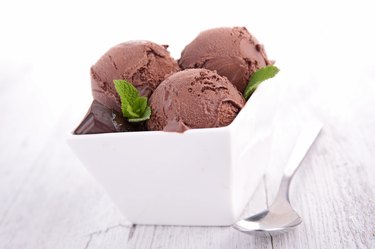
Although some people think you need to give up all sweet treats if you have diabetes, that isn't necessarily the case. Choosing the right foods and properly planning your carbohydrate intake throughout the day can make it possible to indulge on occasion. While ice cream does contain carbohydrates and can increase your blood sugar levels somewhat, it won't necessarily cause blood sugar spikes.
Carbohydrate Content
Video of the Day
The carbohydrate content of ice cream varies. A 1/2-cup serving of chocolate soft serve or the same amount of fat-free, no-sugar-added ice cream in a flavor other than chocolate each has about 19 grams of carbohydrates. A premium vanilla ice cream, on the other hand, can have as much as 24 grams, and other premium flavors, such as those containing chunks of candy or other sweets, can be even higher in carbohydrates. One serving of carbohydrates for a person with diabetes is 15 grams, and people with the condition can usually eat three to five servings per meal or one to two servings per snack and still maintain relatively stable blood sugar levels. This means a 1/2-cup serving of ice cream can take up half of a meal's carbohydrate servings and could contain more than the amount of carbohydrates allowed in a snack.
Video of the Day
Glycemic Index
The glycemic index helps predict how much a particular food is likely to raise blood sugar levels after you eat it. Foods low on the glycemic index with scores of 55 or less don't cause blood sugar levels to increase very much, while those with scores over 76 can cause large increases. Regular half-vanilla, half-chocolate ice cream has a GI of about 57, and low-fat raspberry ripple has a GI of 79. However, some low-fat ice creams have a GI as low as 24, and premium chocolate ice cream has a GI of about 37.
Glycemic Load
The glycemic index doesn't take the typical serving size into account. Because of this, glycemic load can be a better way to estimate a food's potential effect on blood sugar levels. Any score under 10 is considered low. Most ice creams, even the raspberry ripple with the high GI score, still fall within the low category, with scores ranging from 1 to 9. This means as long as you keep your serving size to 50 grams of ice cream, it shouldn't adversely affect your blood sugar levels. This would be slightly less than 1/3 cup of soft serve, about 1/4 cup of premium ice cream or just over 1/3 cup of fat-free ice cream.
Minimizing the Effects
Ice creams with aspartame, sorbitol or mannitol are less likely to raise blood sugar levels than those sweetened with some other types of sweeteners. Choose an ice cream without add-ins, such as candy bits, cookies or flavor swirls. Look for ice creams that are lower in carbohydrates, and eat just a small serving along with a food that is low on the glycemic index or that contains very few carbohydrates since that will lower the overall effect of your meal or snack on blood sugar levels. For example, you can fill your bowl mostly full of a low-GI fruit, such as strawberries or sliced peaches, and top it with just a small serving of vanilla ice cream.
- DiabetesHealth: The Latest ‘Scoop’ on Ice Cream
- University of Kentucky Extension: Carbohydrate Counting
- Clinical Diabetes: The 3 R's of Glycemic Index: Recommendations, Research, and the Real World
- Diabetes Care: International Tables of Glycemic Index and Glycemic Load Values: 2008
- HealthAliciousNess.com: Nutrition Facts Comparison Tool